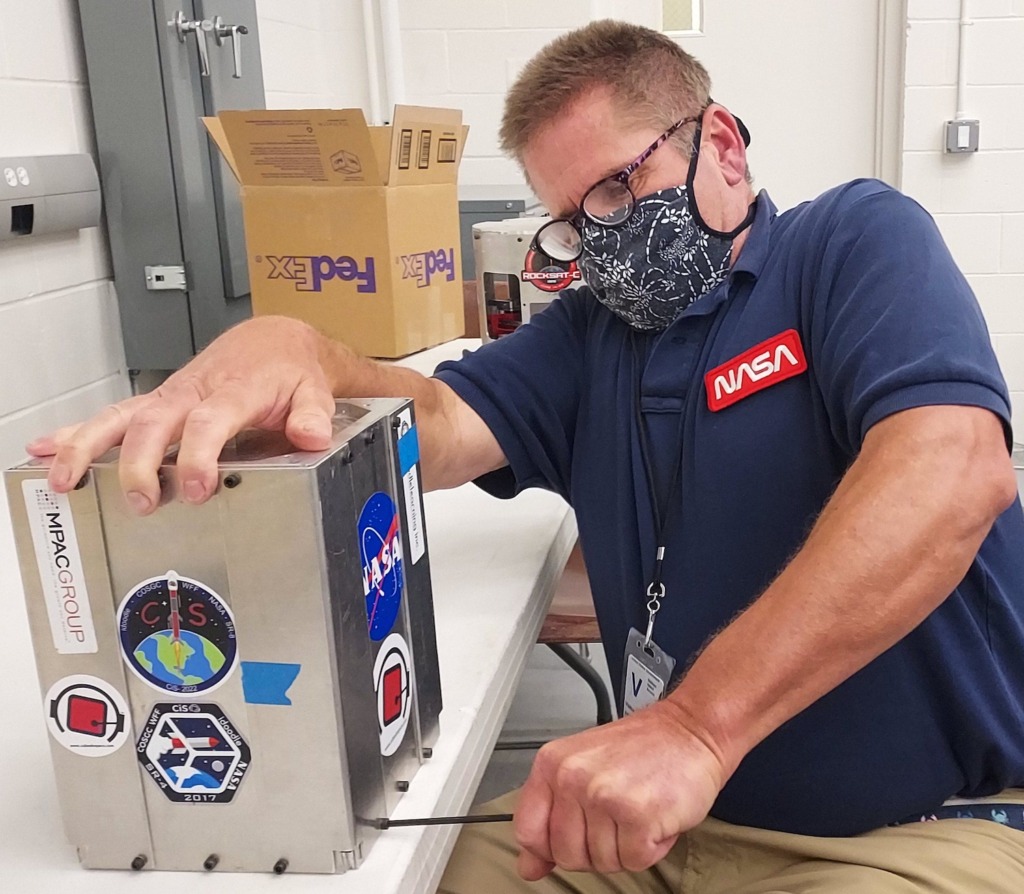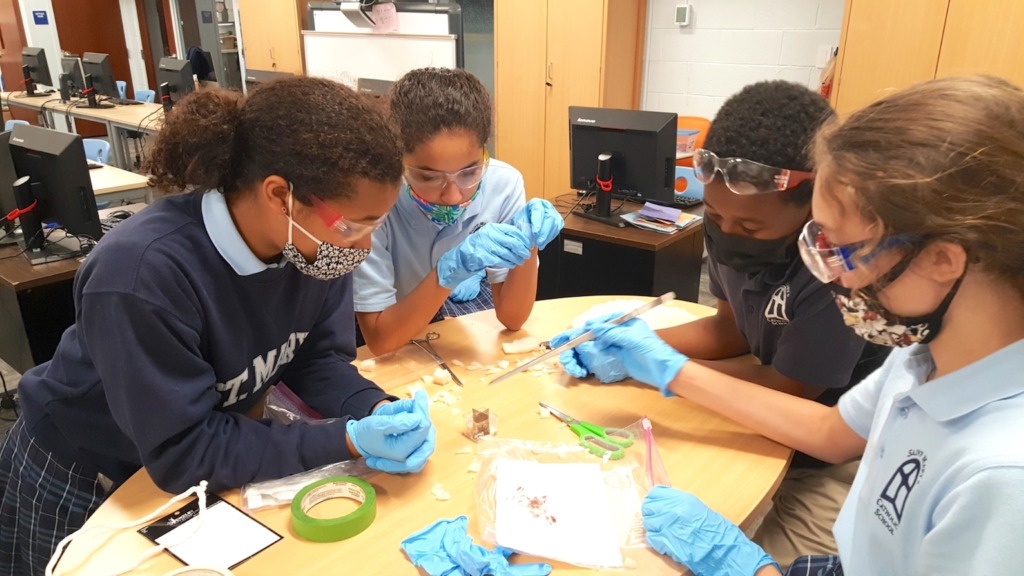St. Mary School accomplishment a multi-year effort
As the sun rose on Friday, June 24, students from St. Mary School, Richmond, looked to the sky as a NASA rocket launched. The shuttle hurled into space while carrying dozens of experiments created by students, including two from St. Mary’s. While the sub-orbital flight lasted only minutes, it was the culmination of years of planning, testing and teamwork.
The international Cubes in Space program works with NASA to offer students aged 11-18 the opportunity to literally let their dreams take flight. Students from 75 countries have participated in Cubes in Space, with more than 1,000 experiments blasting off so far. St. Mary’s group was led by Peter Tlusty, the school’s technology teacher.
Tlusty teaches STEM (Science, Technology, Engineering and Math) to all students from pre-kindergarten through eighth grade, though he adds a couple more letters to the acronym.
“I will often insert an ‘R’ and ‘A’ into STEM to make it STREAM. ‘R’ for religion and ‘A’ for art,” he said. “I reflect on the Catholic Church’s role in science and education. It is amazing the work done by clergy and religious orders in the early and modern ages of medicine, science and astronomy. You can say the Catholic Church started STEM.”
In his class, students work on computers, 3-D printers, drones, coding and more. About 20 students participated in the Cubes in Space team, which met weekly after school and more frequently before the launch. There were countless hours spent brainstorming, designing and experimenting before the team learned they had won a spot on the rocket.
“I am certainly excited and proud when our students get this chance to ‘go to space.’ Not very many people can say they have had experiments travel to space on board a NASA rocket or science balloon. Several of those folks are students, not too many of those are middle school students. Our kids are in an elite group,” Tlusty said.
Rejection, then success
There is a rigorous application process teams must go through before their project can be accepted into Cubes in Space. Tlusty explained that first, the students present their idea and hypothesis for a cube experiment. If the committee likes the idea, they invite the team to write a detailed proposal for space flight.
The students must address all aspects of the experiment, including design and variables. Then Cubes in Space will accept or reject the project. They may also request revisions to the proposal. Each experiment needs to fit and function inside a 4cm x 4cm cube.
Hundreds of ideas are submitted annually, but only a fraction are accepted. Though St. Mary’s had two accepted for this launch, they have received multiple rejections in the past.
“Sometimes rejection is pretty hard, but you have to pick yourself up, make adjustments, and learn from it to do better next go. Our students are good at that!” said Tlusty.

Rejection isn’t the only setback the team has faced. COVID greatly affected the program, canceling the launch in 2020 and forcing the team to meet virtually. While the concepts of their cubes were penned before the pandemic hit, it wasn’t until years later that the projects finally got to be launched.
Last year, 80 cubes were lost in shipping en route to the launch, including the ones from St. Mary’s. The team had to completely rebuild the experiments for this year.
Tlusty said a silver lining of this is the team was able to reconfigure and improve upon the original designs. This year, the cubes were hand-delivered.
Interest in STEM
Ana Reveles Leon, who worked on the cube in the beginning, is now a rising junior at The Steward School in Richmond.
Leon has been interested in STEM studies since childhood.
“I have always been drawn to STEM,” she said. “I have been curious about how the world works and the principles behind gravity, space, etc. Rockets in general and aerospace have always had a special place in my heart.”
The cube experiment she worked on centered on springs. Leon was intrigued by springs because they are capable of being stretched to the point of deformation.
Tlusty explained that the goal of the cube was to engineer a simple accelerometer to measure forces mechanically without the use of electricity or computer chips. The experiment used hand-wound copper wire and lead fishing weights to observe the effects of different Gs on the springs. In traveling 100 miles into space, the rocket experienced 19Gs at lift off, 7Gs during the flight, and 10Gs coming back to Earth with the parachute. The experiment proved successful as the springs did stretch and change shape in response to the Gs felt.
Commitment, dedication
The other experiment sought to find the best method of protecting fragile payload from the intense G-forces rockets experience during their rough rides. A G or g-force is a measurement of acceleration or deceleration, a change in speed over time. A sounding rocket gets going fast in a few seconds, thus producing 19 Gs.
The team experimented with foam, bubble wrap, and polyfill stuffing (found in teddy bears) to ascertain which was best at protecting glass. It turned out that the same material that makes teddy bears so cuddly was also successful at keeping glass secure.
Rising eighth grader Lourdes Olivencia, who serves as team captain, explained why this experiment would be useful to NASA.
“If we can protect a delicate object from breaking during a forceful rocket launch, then we can apply that knowledge to protecting other delicate or sensitive equipment that would travel on rockets,” she said.
Olivencia was tasked with writing the proposal, later making more than a dozen revisions. She also helped manage the team to make sure each individual’s skillset was being utilized.
“If I wasn’t as interested in Cubes in Space, then I wouldn’t have put my whole heart and soul into it,” she said. “The commitment and dedication I saw not just from me but also from the team was truly worth it when I looked back on the whole process.”
Guided by faith
While the process could be stressful at times, the team relied upon their school community, family and faith for support. They also see Cubes in Space as an opportunity to share the gifts with which they were blessed.
Rising eighth grader Sophia Duggar said, “My faith has guided me to fun things like this. I’m using my talent that God has given me to put forward into my projects.”
Olivencia added, “My Catholic faith has guided me by showing me that I can rely on God to put me in the right place and on the right path.”
The team credits much of its successful journey, both literally and figuratively, to Tlusty’s tutelage.
“Mr.Tlusty is a one-of-a-kind teacher. He opened countless doors and made the whole process fun,” said Leon. “Every step of the way, I was excited. He helped us research, get and choose the materials, set up everything, and was overall an amazing mentor. I would not be where I am right now without his support. In the future, I look forward to studying aerospace engineering, all because of his teaching and support.”

